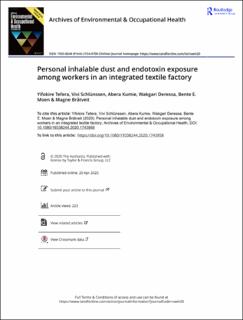| dc.contributor.author | Zele, Yifokire Tefera | |
| dc.contributor.author | Schlünssen, Vivi | |
| dc.contributor.author | Kumie, Abera | |
| dc.contributor.author | Deressa, Wakgari | |
| dc.contributor.author | Moen, Bente Elisabeth | |
| dc.contributor.author | Bråtveit, Magne | |
| dc.date.accessioned | 2021-04-12T13:13:31Z | |
| dc.date.available | 2021-04-12T13:13:31Z | |
| dc.date.created | 2020-05-24T17:04:04Z | |
| dc.date.issued | 2020 | |
| dc.Published | Archives of Environmental & Occupational Health. 2020, . | |
| dc.identifier.issn | 1933-8244 | |
| dc.identifier.uri | https://hdl.handle.net/11250/2737349 | |
| dc.description.abstract | The aim of this study was to determine personal exposure to inhalable dust and endotoxin levels among workers in an integrated cotton-processing textile factory and exposure variability across the different work sections. Full shift measurements were carried out using inhalable conical samplers with 37 mm glass-fiber filters. Personal inhalable dust was determined gravimetrically, and endotoxin levels were analyzed by kinetic chromogenic Limulus Amebocytes Lysate assay. The geometric means of personal dust and endotoxin concentrations were 0.75 mg·m−3 and 831 EU·m−3, respectively. The highest dust and endotoxin concentrations were observed in carding section (1.34 mg·m−3 and 6,381 EU·m−3, respectively). Altogether, 11% of dust and 89% of endotoxin samples exceeded workplace exposure limits. This study showed a moderate correlation between inhalable dust and endotoxin (r = 0.450, p < 0.001). Our findings indicate that low dust exposure does not guarantee a low exposure to endotoxin. | en_US |
| dc.language.iso | eng | en_US |
| dc.publisher | Routledge | en_US |
| dc.rights | Attribution-NonCommercial-NoDerivatives 4.0 Internasjonal | * |
| dc.rights.uri | http://creativecommons.org/licenses/by-nc-nd/4.0/deed.no | * |
| dc.title | Personal inhalable dust and endotoxin exposure among workers in an integrated textile factory | en_US |
| dc.type | Journal article | en_US |
| dc.type | Peer reviewed | en_US |
| dc.description.version | publishedVersion | en_US |
| dc.rights.holder | Copyright 2020 The Author(s). | en_US |
| cristin.ispublished | true | |
| cristin.fulltext | original | |
| cristin.qualitycode | 1 | |
| dc.identifier.doi | 10.1080/19338244.2020.1743958 | |
| dc.identifier.cristin | 1812298 | |
| dc.source.journal | Archives of Environmental & Occupational Health | en_US |
| dc.source.pagenumber | 415-421 | en_US |
| dc.identifier.citation | Archives of Environmental & Occupational Health. 2020, 75 (7), 415-421. | en_US |
| dc.source.volume | 75 | en_US |
| dc.source.issue | 7 | en_US |

